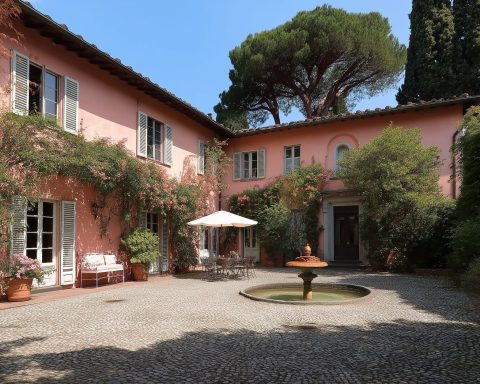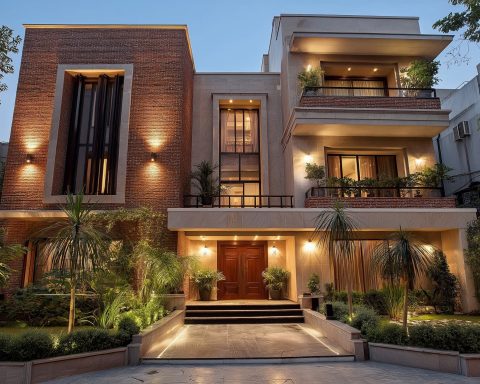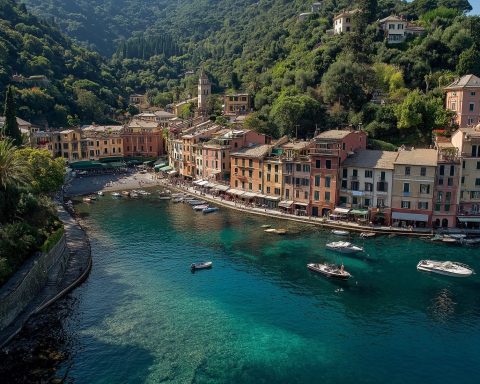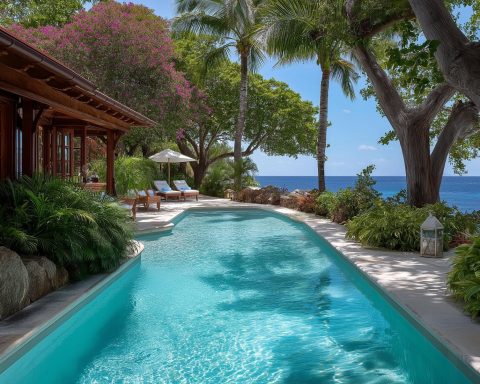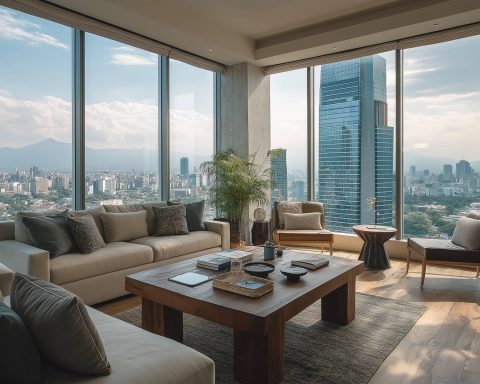Introduction and Economic Context
São Paulo’s real estate market in 2025 is characterized by robust activity and resilience, despite economic headwinds like high interest rates. Brazil’s economy grew about 3.4% in 2024 and is forecast to expand around 2.2–2.3% in 2025, a moderate pace that still supports housing demand globalpropertyguide.com. Inflation has been in the mid-single digits (around 4–5%), and the Central Bank’s Selic rate was raised to 14.75% by mid-2025, its highest in nearly two decades, making mortgage credit expensive riotimesonline.com. Yet, the desire for homeownership and real asset investment remains strong. In fact, real estate sales surged 15% nationally in Q1 2025 even amid costly credit riotimesonline.com, reflecting the market’s resilience. This report provides a comprehensive analysis of São Paulo’s real estate market in 2025 – covering residential and commercial trends, prices and yields, key neighborhoods, new developments and infrastructure, investment opportunities and risks, and forecasts into 2026 and beyond – with comparisons to recent years and insight into regulatory and tax considerations.
Market Overview: The São Paulo metropolitan area (Brazil’s largest city economy) has seen steady property price growth and unprecedented transaction volumes. As of April 2025, house prices in the city were up 6.11% year-on-year (nominal), a faster pace than the 4.93% seen a year prior globalpropertyguide.com. Adjusted for inflation, that equated to modest real growth (~0.5%), but notably the sharpest nominal rise in a decade for São Paulo globalpropertyguide.com. This follows a sustained post-pandemic rebound – prices in 2021–2024 cumulatively rose ~17% in São Paulo globalpropertyguide.com after a flat period in the mid-2010s. Demand has been exceptionally high: 2024 marked a record year for home sales in the city, and that momentum carried into 2025. Meanwhile, the commercial sector, especially offices, is recovering from the pandemic slump with vacancy rates declining and rents rising. The following sections detail these trends and their drivers.
Residential Real Estate Trends in 2025
Surge in Sales and New Supply
Residential real estate in São Paulo is experiencing an unprecedented boom in sales and construction activity. During 2024, the city recorded 103,346 residential sales, a 35.7% jump from the prior year and the highest ever recorded globalpropertyguide.com. This marked the eighth consecutive year of growth in transactions. The trend accelerated further into 2025 – in just the first two months of the year, sales were up 40.6% year-on-year, with over 17,000 units sold by February globalpropertyguide.com. This explosive demand is met by a surge in new development. New housing launches hit a record 104,431 units in 2024, a 42.6% increase over 2023 globalpropertyguide.com. Builders are rapidly adding inventory: January–February 2025 saw 16,940 units launched, up 130% from the same period a year prior globalpropertyguide.com. Such figures underscore a construction boom aimed at keeping pace with buyer appetite.
This high demand is driven by several factors. Housing needs remain high in a metro of 22 million, and even with expensive financing, Brazilians are prioritizing real estate. Industry data show government-subsidized housing programs significantly contributed to the boom: in Q1 2025, the revived Minha Casa, Minha Vida (MCMV) affordable housing program accounted for 53% of new launches and 47% of sales riotimesonline.com. Indeed, the federal government expanded MCMV in 2025 to include middle-income families (up to R$12,000 monthly), offering them subsidized mortgages around 10% interest, well below market rates riotimesonline.com. Major developers like Cyrela benefited from this robust demand, with Cyrela’s Q1 2025 sales up 34% year-on-year riotimesonline.com.
On the supply side, developers are eager to capitalize on the favorable market. Inventory, however, remains tight – a national builders’ association (CBIC) estimate suggested that current housing stock would cover only ~8 months of demand if no new projects came forth riotimesonline.com. In early 2025 there was a slight slowdown in new project approvals (launches in Q1 2025 were down ~28% compared to Q4 2024 riotimesonline.com), due in part to rising construction costs and labor shortages. Construction input costs rose about 6.8% year-on-year riotimesonline.com, and over 70% of builders report difficulty finding skilled labor riotimesonline.com, which could temper the pace of new deliveries. Nonetheless, overall residential construction activity is picking up – analysts project the construction sector’s output to grow ~2.8% in 2025 riotimesonline.com, indicating continued confidence.
Price Movements and Housing Values
Home prices in São Paulo continued on an upward trajectory through 2025, though at a more moderate rate than some other Brazilian cities. As noted, the city’s residential prices in April 2025 were +6.11% year-on-year (nominal) globalpropertyguide.com, accelerating from the prior year’s ~4.9% pace. This gain slightly outpaced inflation, yielding a modest real appreciation. It’s a healthier growth than Rio de Janeiro’s (~4.6% YoY) and in line with São Paulo’s role as a mature market globalpropertyguide.com. For context, Brazil’s national house price index was up ~7.97% YoY by April 2025 globalpropertyguide.com, the fastest since 2013 and driven by explosive growth in smaller cities (e.g. Salvador +20.6%, João Pessoa +18% globalpropertyguide.com). São Paulo’s slower price climb reflects its already high base and greater supply elasticity. Notably, in late 2024 and early 2025 São Paulo experienced its steepest half-year price rise in 10 years globalpropertyguide.com, signaling strong momentum heading into 2025.
In absolute terms, São Paulo remains one of Brazil’s most expensive markets. As of mid-2025, average prices are around R$10,000–R$11,000 per square meter citywide, with prime districts commanding far higher rates thelatinvestor.com thelatinvestor.com. A June 2025 survey put Vitória, São Paulo, and Rio as the top three priciest cities, with Vitória slightly ahead at ~R$13k/m² and São Paulo not far behind thelatinvestor.com. Within São Paulo, prices vary dramatically by neighborhood (see regional analysis below). High-end central zones like Jardim Europa, Itaim Bibi, and Vila Nova Conceição commonly see R$15,000–R$20,000+ per m² thelatinvestor.com thelatinvestor.com. In contrast, more peripheral or emerging areas range from ~R$5,000–R$8,000 per m², making the market diverse thelatinvestor.com. For example, upscale Itaim Bibi and Vila Olímpia average R$12k–18k/m² thelatinvestor.com, whereas suburban districts like Tatuapé or Butantã might be in the high single-thousands. Overall, prime neighborhood prices rose about 5% in the past year thelatinvestor.com, showing steady appreciation in sought-after locales.
On the rental side, rents have been climbing even faster than sale prices. In 2024, residential rents in São Paulo jumped roughly 13.5% on average thelatinvestor.com, driven by fierce demand (especially for units near new transit lines and with home-office space). Rent growth has outpaced inflation, indicating a tight leasing market. This continued into 2025: vacancy rates for rental housing are quite low, averaging only 3–5% thelatinvestor.com, which is indicative of healthy absorption of rental supply. By early 2025, typical monthly rents for a 2-bedroom range from R$4,000–7,000 in prime areas like Jardins or Vila Nova Conceição, down to ~R$2,000–3,500 in more affordable districts like Tatuapé or Butantã thelatinvestor.com. Such rent levels, combined with high sale prices, translate to moderate-to-good rental yields for investors.
Rental Yields and Investment Returns
Gross rental yields in São Paulo’s residential market average around 5–6% in 2025, which is comparatively strong by global city standards, though must be viewed against Brazil’s high interest rates. Research by Global Property Guide finds São Paulo apartment yields averaged ~5.94% in Q1 2025, with individual properties ranging roughly 4.1% up to 8.2% depending on property type and location globalpropertyguide.com. Smaller apartments in less upscale areas tend to generate higher yield percentages, while luxury units in top neighborhoods have lower yields (as prices are high). This ~6% average yield is significantly higher than Rio de Janeiro’s (~3.8%) globalpropertyguide.com, reflecting both stronger rental demand and more reasonable pricing in São Paulo. Local data corroborate that most residential yields fall between 4% and 6% annually thelatinvestor.com – properties in “emerging” neighborhoods or with unique rental appeal can hit the upper end of that range, whereas blue-chip addresses might yield in the 4% range.
Importantly, these yields are gross and before taxes/expenses. With Brazil’s benchmark interest (Selic) at 14%, mortgage borrowing costs are high, so a 5–6% rental return alone might not outpace financing rates. However, investors consider total returns (rent plus price appreciation). São Paulo’s combination of ~6% yield plus mid-single-digit price growth indicates a healthy total return potential in the current cycle, especially if interest rates begin to ease going forward. Additionally, many investors in Brazil utilize Real Estate Investment Funds (FIIs) or cash purchases to mitigate financing costs – the presence of solid yields suggests attractive income streams, and indeed São Paulo remains a preferred destination for both domestic and foreign real estate investors (more on investment climate later).
Key Neighborhoods and Regional Analysis
Location is highly determinant of real estate performance within São Paulo. The market is marked by a stark divide between the affluent central/western zones and the more affordable peripheries. Official city data (analyzed by Loft) show the West Zone now dominates in terms of pricing and liquidity riotimesonline.com. In early 2025, ultra-prime enclaves like Jardim Europa, Itaim Bibi, Vila Nova Conceição, and Moema hit historic price highs riotimesonline.com. For example, Jardim Europa’s exclusive Rua Frederic Chopin saw average home prices of R$49.8 million (for mansions ~1,200 m²), which equates to an astounding R$41,700/m² – more than double its price level of late 2024 riotimesonline.com. Nearby elite addresses in Itaim Bibi also saw units averaging well above R$10 million (e.g. Rua Galeno de Revoredo at R$14.1M) riotimesonline.com. These prestige locations near Avenida Faria Lima (the main financial hub) command São Paulo’s top prices riotimesonline.com. Proximity to major business centers, high-end amenities, and green spaces like Parque do Povo drive their desirability riotimesonline.com. It’s notable that even with Brazil’s high interest rates, demand for luxury real estate is surging – this signals wealth-driven purchases and real estate seen as a safe asset. The luxury segment grew rapidly: in 2023, launches of luxury homes in the Southeast (including SP) were up 63%, and sales values up 42% year-on-year thelatinvestor.com. This has continued making penthouses and upscale units in areas like Alto de Pinheiros especially sought after for their exclusivity and views thelatinvestor.com thelatinvestor.com.
Besides the well-known luxury zones (Jardins, Itaim, Vila Olímpia, Brooklin, Moema, etc.), other sub-markets are emerging or evolving:
- Tech and Creative Hubs: Neighborhoods like Pinheiros and Vila Madalena are seeing a rise in property values thanks to the growth of São Paulo’s tech and startup scene. The city hosts nearly 340,000 tech firms (60% growth since 2014) and many are clustering in Pinheiros and along the Faria Lima axis thelatinvestor.com. As tech companies set up offices nearby, housing demand for young professionals increases. Pinheiros is described as a “prime spot for property investment” due to this tech boom and improved infrastructure thelatinvestor.com thelatinvestor.com. Expect residential and office values in these areas to keep climbing as the innovation economy expands.
- Student and University Areas: Butantã, home to the University of São Paulo (USP), is undergoing demographic shifts. With nearly 98,000 students enrolled at USP in 2024, there is huge demand for rentals and starter homes near campus thelatinvestor.com. Students and academics are flooding the area, driving a mini real estate boom – many properties are being snapped up or rented out to the university community, and furnished apartments are in high demand thelatinvestor.com. This academic-driven market makes Butantã and surrounding districts lively and attractive for investors targeting student housing.
- Infrastructure-Linked Hotspots: Locations along new or expanding transit lines are seeing upticks in interest. For instance, Perdizes (served by a new metro Line 6 station) is projected to have rising rents and prices, as improved public transport historically can boost nearby housing values by up to ~19% thelatinvestor.com. Citywide, São Paulo’s aggressive transit expansion has already influenced rents – much of the 13.5% rental jump in 2024 was attributed to demand for housing near new stations thelatinvestor.com. Other examples include Vila Prudente and Mooca (benefitting from metro expansions in the east) and Morumbi (where new train/monorail links improved access).
- Green and Family-Friendly Districts: There is a trend of families prioritizing neighborhoods with parks and open spaces. Moema has long been desirable for its proximity to Ibirapuera Park, and Morumbi saw rising values after parks like Burle Marx were established thelatinvestor.com. The local government is promoting more green areas; for example, Vila Guilherme in the north is slated for new parks and is expected to attract families seeking an urban-nature balance thelatinvestor.com thelatinvestor.com. Real estate in such areas that offer a better quality of life (less concrete jungle, more leisure space) is seeing a demand uptick.
- Central Revitalization – Anhangabaú: In downtown, the Anhangabaú valley area is targeted by new zoning incentives to spur high-rise residential development. Zoning law reforms in 2023–24 (City Bill No. 127) now allow developers to build taller buildings in transit-rich central zones if they include affordable housing units thelatinvestor.com. The city is even buying unsold units from developers to bolster housing supply downtown thelatinvestor.com. These measures aim to address housing shortages and revitalize São Paulo’s central core. Anhangabaú is poised for a skyline transformation, with more high-rises expected, blending market-rate and accessible housing thelatinvestor.com. Over time, this could make the central city more vibrant and ease pressure on outlying areas.
Overall, São Paulo’s real estate landscape in 2025 is a mix of ultra-luxury growth in the established west/south sectors, solid demand in middle-class and emerging areas, and targeted policy-driven development in the center and underserved zones. The gap between wealthy districts and the rest remains pronounced – a trend highlighted by record prices on elite streets even as affordability challenges grow elsewhere riotimesonline.com. Policymakers are challenged with balancing this growth with inclusion, as soaring values in top neighborhoods reinforce socio-economic divides riotimesonline.com. For investors and market participants, these regional dynamics underscore the importance of location-specific strategy.
Commercial Real Estate Trends in 2025
Office Market Recovery and Rents
São Paulo’s commercial real estate, particularly the office sector, has entered 2025 in recovery mode, shaking off the worst of the pandemic-era downturn. Office vacancy rates are falling sharply as companies return to in-person work and expand operations. In Q1 2025, the vacancy rate for high-end (Class A/A+) offices dropped to 18.3%, the lowest since the pandemic began jll.com. This is a notable improvement from roughly a 23% peak vacancy in 2021 siila.com.br. The tightening supply is even more dramatic in premium sub-markets: between April 2024 and April 2025, overall office vacancy fell from 20.3% to 18%, but prime “AAA” buildings saw vacancy plunge from 17.3% to just 12.6% riotimesonline.com. Essentially, top-quality offices are nearing full occupancy, reflecting flight-to-quality trends among tenants.
Rents are responding accordingly. With demand up and vacancies down, asking rents for prime offices have risen. As of early 2025, the average asking rent for high-end offices reached ~R$109/m² per month, up about 15% from the start of 2024 jll.com. Landlords of coveted properties (especially new or upgraded buildings) have greater pricing power now than at any time in the last 3–4 years. For example, in the Paulista Avenue region – one of the traditional office corridors – commercial rents average around R$250/m² monthly for top spaces thelatinvestor.com. This reflects robust demand and the willingness of businesses to pay a premium for prime locations. Many office buildings in Paulista have undergone retrofitting (over 35% of high-standard properties there have been refurbished in recent years) thelatinvestor.com, indicating landlords investing to attract tenants. The city government’s plan to relocate public offices to downtown/Paulista will further bolster office demand in the core thelatinvestor.com.
Net absorption figures underscore the strength of the office rebound. In Q1 2025 alone, São Paulo recorded gross absorption of ~187,000 m² and net absorption of 105,000 m² of offices jll.com – meaning a large amount of space was leased and occupied in just one quarter. Similarly, in the Jan–Apr 2025 period, net absorption totaled 107,400 m², which was 23% higher than the same period in 2024 riotimesonline.com. Premium AAA buildings did particularly well, absorbing 36,000 m² (up 21% year-on-year) riotimesonline.com. This positive absorption has been helped by limited new supply. Only about 23,700 m² of new office space delivered citywide in Jan–Apr 2025 riotimesonline.com, less than half the new stock from early 2024. Developers are strategically holding back or phasing projects to avoid oversupply. A case in point is the massive Esther Towers project (94,000 m²) in the South Zone; its developer, EZTec, has slowed construction, awaiting firm tenant pre-commitments before completion riotimesonline.com riotimesonline.com. Such restraint means demand is filling existing vacancies without being outpaced by new deliveries, driving vacancies down.
Key office sub-markets are benefiting unevenly. The hottest corporate address in São Paulo remains the Faria Lima – Vila Olímpia – Berrini – Chucri Zaidan corridor in the West/Southwest. JLL reports that in Q1 2025, 70% of all office space demand in primary areas was concentrated in the “Berrini-Chucri Zaidan” axis jll.com (this is a stretch of modern business districts in the south/west). In these areas, vacancy is well below the city average: as of Q1, Berrini’s vacancy was just 13.4% and Chucri Zaidan’s 16.5% jll.com. Many large blocks of space that were empty have been taken – out of nine big office developments that had >10,000 m² vacant at end of 2024, only five still had such availabilities by Q1 2025 jll.com. The Paulista Avenue area, while still important, is evolving; older office stock there is being upgraded and the area is becoming even more commercial (as noted, significant retrofitting and rising rents). Other sub-markets like Pinheiros (emerging with creative and tech firms) and Barra Funda (more back-office and budget offices) are also seeing activity. On the flip side, secondary locations and aging buildings that don’t meet modern tenant expectations (e.g., lacking amenities or transit access) are slower to lease. Overall, however, the office outlook is increasingly positive – “the market is hot and deals are happening” as JLL’s office director put it, noting that unlike typical seasons, even early 2025 saw a lot of corporate move-ins jll.com.
Retail, Industrial, and Other Commercial Segments
While offices grab headlines, São Paulo’s other commercial real estate segments present a mixed picture:
- Retail Properties: The retail real estate segment is closely tied to consumer spending. Brazil’s solid economic growth of ~3% in 2023–24 and a recovering job market have helped shopping center foot traffic and high-street retail. Prime retail zones (like Oscar Freire Street for luxury, or shopping malls in affluent districts) have mostly bounced back from pandemic lows, with vacancy rates declining and rents stabilizing. That said, e-commerce growth keeps brick-and-mortar retailers selective in expansion. Demand is strongest for well-located spaces that offer experiential retail or serve daily needs in dense neighborhoods. No major oversupply of malls is noted in São Paulo currently; on the contrary, some new mixed-use projects are incorporating shopping and dining components in growing areas (e.g. planned developments in expanding suburbs). Retail rents in prime malls have likely risen modestly in 2025, though detailed data is less public – landlords report improved occupancy and sales. Overall retail CRE is steady, bolstered by the city’s large consumer base and returning tourism, but faces the structural challenge of online competition.
- Industrial and Logistics: The logistics/industrial real estate market in Greater São Paulo has been very dynamic, fueled by e-commerce, third-party logistics, and a post-pandemic reconfiguration of supply chains. Vacancy for modern warehouses in the São Paulo region reached historic lows in recent years, and rental rates have climbed. For instance, average logistics rents jumped from around R$19/m² in 2020 to nearly R$25/m² in 2024 cushmanwakefield.com. In 2025, there continues to be strong demand for distribution centers around São Paulo’s fringes (Guarulhos, Cajamar, Barueri, etc.). Cap rates for industrial assets remain relatively high (often in low double-digits) attracting investors – e.g. one February 2025 transaction in Cajamar reflected a 14.9% cap rate for a logistics asset siila.com.br, aligning with high interest rates in the economy. New supply is coming online in key corridors, but absorption has been healthy. With São Paulo being Brazil’s logistics hub, the industrial real estate outlook is positive: stable or rising rents and low vacancy in prime big-box warehouses, albeit tempered by interest rate impacts on financing development.
- Hospitality and Mixed-Use: The hotel sector in São Paulo is recovering as business travel and events resume. Occupancy rates and daily rates in 2025 are much improved over 2020–21 lows, though not fully back to peak. This has renewed interest in hotel and serviced apartment developments in the city’s business districts. Additionally, many mixed-use projects are underway that blend offices, residences, retail, and hospitality. Developers focus on live-work-play complexes, especially in the West and South zones, to meet demand for integrated urban living. This trend reflects both an urban planning push and market preference – new projects in areas like along the Marginal Pinheiros or expanded metro lines often include commercial components on lower floors (shops, co-working) and residential above.
In summary, commercial real estate in São Paulo in 2025 is broadly on an upswing. Offices lead the way with a vigorous rebound in occupancy and rent growth, particularly in high-end segments. Retail is stable to improving in prime locations, and industrial/logistics remains a star performer with sustained demand. One risk to watch is if interest rates stay elevated longer than expected – this raises capitalization rates (reducing property values) and makes financing costly for new commercial developments. For now, however, investor sentiment in São Paulo’s commercial property is upbeat, supported by the city’s role as Brazil’s economic engine.
New Developments, Infrastructure, and Urban Planning
Major infrastructure projects and urban development initiatives are reshaping São Paulo’s real estate landscape and are key to its future growth. In 2025 and the next few years, a number of significant projects are underway or planned, spanning transportation, public works, and large-scale real estate developments:
- Mass Transit Expansion: São Paulo is in the midst of a historic expansion of its metro and rail network. Metrô Line 6 (Orange) – a new 15 km subway line connecting Brasilândia (northwest) to São Joaquim (city center) – is slated to open by 2025 acciona.com acciona.com. This line will serve over 600,000 passengers/day and bring metro service to underserved areas, including the Perdizes and Pompeia neighborhoods, which as noted is already impacting nearby property values. Additionally, the city is extending Line 2 (Green) further into the eastern suburbs with support from international funds worldbank.org, and completing Line 17 (Gold), a monorail serving the airport area (Morumbi to Congonhas). These projects improve urban mobility and typically boost real estate demand around new stations. Studies show housing prices can increase on the order of ~10–20% in areas gaining a new metro stop thelatinvestor.com. Accordingly, developers are concentrating new projects in transit-rich zones, aligning with the city’s transit-oriented development goals.
- Roads and Logistics Infrastructure: The State of São Paulo in 2025 is investing heavily in infrastructure, with a planned R$33.5 billion (US$5.4bn) outlay – a record level bnamericas.com. Key projects include highway improvements such as the completion of the Rodoanel (beltway) northern segment, upgrades to major highways (e.g., Bandeirantes, Anchieta), and regional development corridors (projects like Rota dos Bandeirantes, etc.). The state government announced nearly R$15 billion for regional initiatives (Paranapanema, Rota Mogiana, Circuito das Águas) to improve roads and utilities in the interior riotimesonline.com. For the city, improved highways and a push for expanding bus rapid transit (BRT) lanes and a planned light rail (VLT) in the central area vectio.com will further bolster connectivity. Better logistics infrastructure enhances the appeal of industrial parks around the metro and can open up new areas for commercial development.
- Urban Revitalization and Zoning: São Paulo’s urban planning strategies in recent years focus on densification along transit corridors and revitalizing the core. The 2024 Master Plan revisions and zoning law changes encourage high-rise, mixed-income projects in central and well-located districts. As mentioned, the city passed legislation allowing extra building height in exchange for inclusion of affordable units (e.g., Bill 127) thelatinvestor.com. This “inclusionary zoning” aims to direct private investment into creating more housing supply in job-rich areas and address the housing deficit. The city has also been acquiring housing units from developers in central areas like Anhangabaú to provide social housing and reduce vacancy in older downtown buildings thelatinvestor.com. Another urban program in effect is the designation of certain private green areas as public utility, allowing the city to preserve/create parks in exchange for development rights elsewhere thelatinvestor.com. This incentivizes developers to integrate green space in projects or contribute to public parks, as seen in areas like Chácara Flora and new parks planned for Vila Guilherme thelatinvestor.com thelatinvestor.com. Overall, these urban planning moves seek to create a more sustainable, transit-oriented city, containing sprawl and improving livability – factors that in turn make São Paulo real estate more attractive.
- Notable Real Estate Developments: The private sector is responding with large-scale developments across São Paulo:
- In the commercial office sphere, besides the mentioned Esther Towers (94k m²) which will be one of the largest office complexes once completed, there are new corporate towers rising in the Faria Lima/Itaim region, and in Brooklyn/Chucri Zaidan where projects like Parque da Cidade complex continue to expand. Many of these are mixed-use, including office, retail, and sometimes residential/hospitality components.
- On the residential side, mixed-use mega-projects are a trend. The “Reserva Alphaville” in Barueri (metro west) and “Parque Global” in the south are examples of master-planned communities featuring residential towers, shopping, and leisure facilities. In central areas, developers like Setin and Tegra have launched multi-tower projects that incorporate co-working spaces and ground-floor retail to align with the live-work-play demand.
- There is also growth in the build-to-rent (multifamily) segment – a relatively new concept in Brazil. Some major companies are converting land and buildings into institutionally owned rental apartment complexes siila.com.br, signaling an evolution in the residential market model. This could increase quality rental supply and cater to a young professional demographic that prefers renting in amenity-rich buildings.
In summary, infrastructure and development projects in São Paulo are both consequences of and catalysts for the real estate boom. Improved transit and ambitious urban policies (zoning for density, greening initiatives) are unlocking new opportunities across the city. Buyers and investors are keenly watching where the next metro line or road will go, as those locales often see outsized property appreciation. The city’s commitment to modernizing infrastructure (supported by federal and international funding in some cases) bodes well for long-term growth, though it requires careful planning to ensure inclusive development.
Investment Opportunities and Risks
São Paulo’s real estate market presents a rich set of investment opportunities – from high-yield rental apartments to prime offices and emerging neighborhood developments – but also comes with notable risks that investors should heed.
Opportunities:
- Robust Rental Income: With residential rental yields averaging 5–6% in São Paulo globalpropertyguide.com, investors can earn solid income streams. These yields are attractive relative to other global cities (many of which have sub-4% yields) and provide a hedge against inflation. High demand for rentals (vacancy ~3–5% thelatinvestor.com) ensures landlords can find tenants quickly, especially in central areas or near universities. The growing young professional population and students in São Paulo underpin a strong rental market.
- Capital Appreciation Potential: Property values in São Paulo have shown steady appreciation, and while the mature market means growth is moderate (mid-single digits annually in prime areas globalpropertyguide.com), certain segments have potential for outsized gains. For instance, emerging neighborhoods connected to new infrastructure (metro extensions, etc.) can see property price jumps in the coming years. Early investors in districts like Perdizes (Line 6), or along planned transit lines, could benefit from significant appreciation as connectivity improves thelatinvestor.com. Likewise, investing in up-and-coming areas with urban revitalization plans (e.g. central São Paulo’s revival) could yield strong returns as these locales gentrify.
- Luxury and Upscale Segments: The luxury market in São Paulo is booming, indicating opportunities for high-end developments or flips. Neighborhoods such as Itaim Bibi, Jardim Europa, Vila Nova Conceição have record-breaking prices in 2025 riotimesonline.com, but demand remains deep among wealthy Brazilians and international buyers. Projects catering to this segment (e.g. boutique luxury condos, penthouses in Alto de Pinheiros with panoramic views thelatinvestor.com) are selling well and often at premium pricing. Investors who can participate in luxury developments may see substantial profits, as evidenced by the 34% rise in luxury home launches in 2023 and continuing strength thelatinvestor.com.
- Commercial and REIT Investments: The office market recovery opens opportunities in commercial real estate. Buying into prime office buildings (or shares thereof) while vacancies are still above pre-pandemic levels could be a bet on further recovery – already rents are rising and vacancies falling jll.com. Moreover, Brazil’s Real Estate Investment Funds (FIIs) allow individuals to invest in diversified real estate portfolios (offices, shopping centers, logistics warehouses, etc.) with certain tax advantages. Many FIIs trade on the stock exchange and distribute rental income. Under current rules, individual investors enjoy income tax–free dividends from FII shares (if the fund has 50+ investors and other conditions) practiceguides.chambers.com. This makes FIIs akin to REITs and a popular, relatively liquid way to invest in São Paulo’s property sector without directly owning property.
- Portfolio Diversification and Currency Play: Foreign investors looking at São Paulo can diversify geographically. The Brazilian real (currency) has periods of weakness that can make assets relatively cheap in USD or EUR terms, potentially offering forex upside if the real strengthens. Some international investors are already active, drawn by Brazil’s large market – São Paulo remains “an attractive destination for foreign investors, particularly from Europe and Asia” thelatinvestor.com. With proper due diligence, foreign buyers can capitalize on local market knowledge (often via partnerships or local funds). Regulations allow foreigners to freely purchase urban real estate; one simply needs a Brazilian tax ID (CPF) to buy property, with no major restrictions on urban acquisitions by non-residents globalpropertyguide.com.
Risks:
- High Interest Rates and Financing Costs: Brazil’s interest rates are currently very high (Selic 14.75% riotimesonline.com), which translates to mortgage rates often in the mid-teens. While some sources noted mortgage rates had fallen into single digits in 2024 thelatinvestor.com, the tightening cycle pushed them back up by 2025. Expensive credit can dampen buyer affordability, especially in middle-class segments. ABECIP (the mortgage lenders association) forecast a 17% drop in home loans via savings banks in 2025 riotimesonline.com due to these costs. Investors relying on leverage will face higher debt service costs, potentially squeezing returns. If high rates persist, real estate activity could cool and price growth could slow. That said, many expect rates to start easing if inflation is under control; a lot hinges on the Central Bank’s moves in late 2025–2026.
- Economic and Political Uncertainty: While current forecasts for Brazil’s GDP growth are modest but positive (~2% in 2025 globalpropertyguide.com), any downturn or political instability could affect real estate. For instance, if Brazil’s economy were to slow more than expected or enter recession, demand for both housing and commercial space would suffer. Political risk is also a factor – changes in government policies after the 2026 general elections could impact things like development regulations, taxes, or foreign investment rules. São Paulo’s state and city politics (e.g., mayoral elections) can influence local property taxes and zoning. Investors should monitor macroeconomic indicators and policy signals, as Brazil has had cycles of boom and bust.
- Affordability and Overheating in Pockets: Rapid price increases in certain neighborhoods raise concerns of reduced affordability and potential bubble-like conditions in those pockets. If prices in prime areas keep rising far above income growth, the pool of new buyers shrinks and those markets could stagnate. Already, there’s a noted “urban wealth divide” riotimesonline.com – high-end enclaves become ever more exclusive, which, while good for existing owners, could lead to political pressure (e.g., higher property taxes or development controls) or simply hit a ceiling if locals are priced out. On the flip side, developers flooding the market with small units (São Paulo saw a trend of many micro-units launched in recent years) might lead to oversupply in specific segments. The record launches of 2024–25 globalpropertyguide.com, if not matched by sustained absorption, could result in elevated inventory in the mid-term, which might force price corrections or sales incentives.
- Regulatory and Tax Changes: Investors must navigate Brazil’s tax and legal system, which can be complex. Property purchase involves transaction taxes (~3% ITBI in São Paulo) and fees totaling ~4–6% of price taxsummaries.pwc.com thelatinvestor.com. Holding property incurs annual IPTU property taxes (which in SP range roughly 0.5% to 1.5% of value, on a progressive scale) angloinfo.com thelatinvestor.com. Rental income is subject to taxation (individual landlords pay income tax up to 27.5%). There have been recent discussions on tax reform; for example, a 2025 proposal initially threatened to tax FII rental income (via new IBS/CBS taxes), but after industry pushback the government signaled it will preserve the FII tax exemptions practiceguides.chambers.com. Such shifts in tax policy could affect investment returns. Additionally, any reinstatement of rental price controls (not currently in place, but a risk in a high inflation scenario) or stricter landlord-tenant laws could alter the rental yield equation. Investors should stay updated on regulatory changes, engage good legal counsel, and perhaps structure investments (e.g., via Brazilian holding companies or funds) to optimize tax efficiency.
- Currency Risk: For foreign investors, Brazil’s currency can be volatile. A depreciation of the Brazilian real can erode USD/EUR returns on a property investment (though it also makes buying in cheaper initially). This is a double-edged sword – while the real has been relatively stable recently, global market shifts or domestic issues could cause swings.
In balancing these factors, São Paulo’s real estate remains a high-potential but not risk-free investment environment. The city’s fundamentals – a massive population, role as financial hub, housing deficit, and improving infrastructure – provide a strong underpinning for long-term growth. However, short-term cyclical risks (interest rates, economic shifts) and structural issues (inequality, bureaucracy) must be managed. Prudent investors are adopting strategies like focusing on transit-linked projects, using local partnerships, or diversifying via real estate funds to mitigate some of these risks.
Forecasts and Outlook for 2026 and Beyond
Looking ahead, expert projections and economic indicators suggest that São Paulo’s real estate market will continue to grow in 2026 and subsequent years, but likely at a moderate and sustainable pace rather than an unchecked boom. Here are key points from forecasts:
- Continued Price Growth: Analysts project that Brazilian real estate as a whole will see prices rise on the order of 6–10% annually through 2026, with some variance by region thelatinvestor.com. For São Paulo specifically – being a mature market – the expectations are for mid-single digit annual price increases in the near term (perhaps in the 5–7% range). A composite forecast cited a ~5% compound annual growth for 2025–2026 nationwide thelatinvestor.com. This assumes no major shocks and is underpinned by persistent housing shortages, urban population growth, and government support for housing. Through 2030, the Brazilian residential market is projected to grow at about 5.4% CAGR in value, expanding from ~$62.8 billion in 2025 to ~$81.7 billion in 2030 thelatinvestor.com. São Paulo, as a significant share of that market, should mirror this steady growth trajectory – perhaps slightly slower if interest rates restrain it, or faster if economic growth surprises to the upside.
- Key Drivers: A few factors will drive the outlook:
- Interest Rates Path: A critical assumption is that the Selic rate will stabilize and eventually decline from its peak. If inflation continues to moderate, many expect rate cuts in late 2025 into 2026, which would reinvigorate mortgage lending and buyer affordability. This would be a boon to the housing market, potentially accelerating sales and price gains in 2026. Conversely, if high rates persist longer, the market could cool. Most baseline forecasts factor in easing monetary policy by 2026 thelatinvestor.com.
- Economic Growth: Brazil’s economy is forecast to expand modestly (~2% annually in the medium term thelatinvestor.com). São Paulo, being the engine, might outperform that slightly. Steady GDP and income growth at this level supports real estate absorption but also keeps it in check – we’re not looking at double-digit growth unless there’s an unexpected boom. Unemployment has been trending down, and if that continues, more households will be financially capable of buying homes.
- Demographics and Urbanization: São Paulo will continue to attract migrants and new households. The metro population is still growing (projected ~22.8 million by 2024 thelatinvestor.com and rising further thereafter). Young adults seeking housing, combined with an undersupply of units over past decades, means fundamental demand will remain high. This underpins a positive long-term outlook – even if short-term cycles fluctuate, the city needs more housing and commercial space for its growing, evolving populace.
- Government Policy: The continuation of housing programs (MCMV or its future iterations) and any new incentives will influence the affordable segment. The current administration’s expansion of subsidies (like including middle-income in MCMV at 10% interest riotimesonline.com) suggests support will remain. Also, large-scale infrastructure improvements finishing in 2025–2027 (metro lines, etc.) will unlock new areas for development, as discussed, which can create localized growth spurts.
- Segment Outlooks:
- For residential, expect a normalization to stable growth. After the frenetic surge of 2024–25 (with record sales and launches), the market may temper slightly. ABRAINC (developers association) and Secovi-SP might predict slightly lower volume growth in 2026 simply because 2025 set a high benchmark. But overall growth continues given unmet demand. Prices in São Paulo likely won’t repeat 2021–22’s big jumps; instead a more measured rise in line with inflation or a few points above is seen as healthy. Some regions (e.g., the Northeast cities like Fortaleza, Salvador) may continue to outpace São Paulo in percentage growth thelatinvestor.com, but São Paulo will still see reliable appreciation and remain the volume leader.
- For commercial/offices, many analysts see 2025 as the start of a cyclical upturn. By 2026, if economic conditions hold, São Paulo’s office vacancies could potentially compress to low-teens percentage or even single digits in prime areas, which would drive further rent increases (though at a slower pace after the initial spike). However, new office supply scheduled for 2025–26 (projects delayed during the pandemic now completing) could keep vacancy from falling too fast nmrk.com. The outlook for offices is cautiously optimistic: improving fundamentals but not yet a landlord’s market citywide by 2026, unless the economy accelerates. For logistics/industrial, the consensus is strong – nearshoring and e-commerce trends could sustain high occupancy; some forecasts predict continued rental growth but at a moderating pace as more warehouses come online.
- For retail/hospitality, assuming no new COVID-like disruptions, 2026 should be a period of consolidation and growth. Retail rents may start to climb again in prime retail streets, and new mall projects could be contemplated as consumer confidence returns.
- Risks to Outlook: Analysts do flag a few factors that could moderate the growth projections. Chief among them is the “current high Selic rate of 14.75% making mortgages expensive, potential economic slowdown with GDP growth only ~2%, and affordability constraints as property prices outpace wage growth” thelatinvestor.com. These could somewhat cap price growth in markets like São Paulo to the lower end of forecasts (e.g. 5-6% instead of 9-10%). On the other hand, any sign of quicker inflation drop or stronger economic reforms could boost confidence and thus the real estate market.
- Long-Term View: By 2030, São Paulo will likely remain the dominant real estate market in Latin America’s largest economy. Urban analysts foresee increased verticalization (more high-rises), smarter city initiatives (transit-oriented, green building, etc.), and a deeper capital market for real estate (more REIT-like instruments, more foreign institutional investment). The market’s maturation could lead to lower nominal growth but more stability. One can expect rental yields to gradually compress if interest rates normalize lower – for example, yields might go from ~6% toward 4–5% over the long term, similar to global trends, which implies property values rising faster than rents in such a scenario.
In conclusion, the forecast for São Paulo real estate through 2026 and beyond is broadly positive, emphasizing steady growth rather than a bubble. The city’s fundamentals (population, economic role) support ongoing demand, and while 2025 saw red-hot activity, a gentle cooling to a sustainable expansion is anticipated. Market participants should plan for mid-range growth in values, keep an eye on macro factors (especially interest rates), and recognize that regional variations will persist – e.g., Northeast Brazil may continue to outperform in growth rate, whereas São Paulo and Rio see more “moderate appreciation” off a high base thelatinvestor.com. Nonetheless, São Paulo will continue to be a centerpiece for real estate investment, with its diverse opportunities across residential and commercial sectors.
Government Regulations and Tax Implications
Anyone engaging in São Paulo’s real estate – whether buying a home, selling, or investing – should be aware of the government regulations and taxes that apply. Brazil’s legal framework for real estate is well-established, though it can be complex. Below is an overview of key regulatory and tax considerations:
- Property Transfer and Transaction Taxes: When purchasing property, the main tax is the ITBI (Imposto de Transmissão de Bens Imóveis), a municipal transfer tax. In São Paulo city, the ITBI rate is 3% of the property value taxsummaries.pwc.com. This is typically paid by the buyer upon registration of the sale. Additionally, there are notary and registration fees and often a broker’s commission (usually ~6% paid by the seller). All told, transaction costs for a buyer in São Paulo usually total around 4–6% of the purchase price when factoring in taxes and fees thelatinvestor.com. Note that if one buys through a share deal (acquiring a company that owns property), there might be ways to reduce taxes, but authorities scrutinize such structures to ensure they have economic substance practiceguides.chambers.com.
- Property Ownership Taxes (IPTU): Owners of real estate in São Paulo pay an annual IPTU (Imposto Predial e Territorial Urbano), which is the city property tax. The IPTU is calculated on the assessed value of the property and is graduated. For residential properties, rates generally range roughly 0.5% up to about 1.5% of assessed value per year, depending on the value and usage angloinfo.com thelatinvestor.com. Commercial properties have slightly higher rates (often up to 1.5% or a bit more). For example, a mid-priced apartment might incur ~1% of its value annually in IPTU. The city periodically updates the property value rolls; in 2024 the São Paulo municipality approved up to a 10% increase in the property valuation base for IPTU, meaning some owners saw their tax bills rise siila.com.br. There are exemptions and discounts for certain cases (low value properties, senior or disabled owners with one home, etc.) en.clickpetroleoegas.com.br. Overall, IPTU is a carrying cost to factor into investment returns.
- Income Tax on Rental Income: If you rent out property, rental income is subject to Brazilian income tax. For individual landlords who are tax residents, rental income is added to their other income and taxed at the progressive rates (up to 27.5%). There is a monthly withholding (carnê-leão) for individuals receiving rent above a threshold, which is then consolidated in the annual tax return. However, many individual landlords can deduct a notional 25% of rent as expenses, and there are specific exemptions (e.g., if rent is below a low threshold). Non-resident landlords face a flat 15% withholding tax on gross rent (or 25% if resident in a tax-haven jurisdiction). Investors sometimes structure property ownership through a Brazilian company or fund to optimize taxes. One popular vehicle is the FII (Real Estate Investment Fund) as mentioned: if an individual invests via an FII that owns properties, the distributed rental income can be tax-free for them, provided conditions (fund with 100+ investors, <10% owned by one investor, etc.) are met practiceguides.chambers.com. This makes FIIs very tax-efficient. There is also an RET (Special Tax Regime) for development projects via an SPE company, taxing the developer’s revenue at a favorable composite rate – relevant for builders selling units practiceguides.chambers.com.
- Capital Gains Tax: When selling property, individuals are subject to capital gains tax on any profit. The gain is calculated as the sale price minus acquisition cost (adjusted for inflation up to 1996, plus documented improvements). For Brazilian residents, the tax rate is progressive: 15% on gains up to R$5 million; 17.5% on the portion from R$5–10m; 20% on portion from R$10–30m; 22.5% on any portion above R$30m taxsummaries.pwc.com taxsummaries.pwc.com. Non-residents generally pay a flat 15% on gains (25% if the seller resides in a low-tax jurisdiction) brazilbeachhouse.com. There are important exemptions: Brazil grants a full CGT exemption if an individual sells their sole residential property for up to R$440,000 and has not sold another in the past 5 years. Another exemption: if an individual sells a residence and uses the proceeds to buy another residence in Brazil within 180 days, the gain can be exempt (this can be used once every few years) auxadi.com. These rules encourage re-investment in housing. It’s also worth noting that selling via a corporate structure might avoid some tax (e.g., selling company shares instead of the property triggers ITBI exemption but authorities may tax it as property sale if solely a vehicle practiceguides.chambers.com). Proper tax planning and local advice are essential for sellers to minimize CGT legally.
- Foreign Buyer/Seller Considerations: Foreigners are generally welcome to invest in urban real estate in Brazil, including São Paulo. There is no restriction on foreign ownership of apartments, houses, or commercial units in the city – you do not need to be a resident. A CPF (tax identification number) is required, which foreign investors can obtain globalpropertyguide.com. Funds must come through the official banking system (to register foreign capital if you plan to repatriate gains later). The only restrictions mainly apply to rural land and areas near national borders (which is not applicable inside São Paulo city) globalpropertyguide.com. When foreigners sell property and take money out, they must pay the capital gains tax as noted, and also be mindful of exchange rates and any repatriation registration to avoid double taxation. Rental income for non-residents is taxed via withholding as mentioned. It’s advisable for foreigners to work with lawyers and perhaps hold properties via a Brazilian entity for simplicity if doing multiple deals.
- Regulatory Environment: Brazil’s legal system provides strong protection of property rights and enforces contracts (such as leases). The residential rental law (Federal Law 8,245/1991) gives landlords the right to adjust rent annually by inflation and to reclaim the property at contract end or if tenant breaches. Eviction for non-payment can take a few months via court but has become more streamlined in recent years. Commercial leases have more flexibility and can have longer terms freely negotiated practiceguides.chambers.com. In São Paulo, short-term rental (Airbnb-type) is allowed, though condo associations can regulate it in their buildings. Construction and development are heavily regulated by the city’s zoning and building codes – one needs local permits (alvará) and must comply with use, height, and density rules which have been evolving (e.g., the 2014 Strategic Master Plan and 2024 revisions). There are “Operações Urbanas” (urban operation districts) in São Paulo where developers can pay fees to exceed zoning limits, funding public improvements. Developers also contribute via Outorga Onerosa (a charge for additional building rights), which is part of the cost of projects. Those looking to develop should study the zoning law changes – as noted, recent changes favor high-density along transit and in center, while perhaps restricting in others (some purely residential zones remain protected).
- Taxes on Ownership via Entities: Many larger investors use corporate structures (Ltda or S/A companies, or investment funds). Regular corporations pay corporate income tax on rental income and gains (~34% combined rate), but often can offset costs. There’s also a tax on vacant urban land in São Paulo (to discourage land banking) – higher IPTU rates can apply if a lot is undeveloped. For those investing in land for development, be aware of this and project timelines accordingly.
In essence, buyers should budget for ~5% acquisition costs, annual property taxes, and eventual sale taxes, and ensure compliance with Brazil’s paperwork (registering transactions in the official registry, etc. is critical – unregistered transfers aren’t legally effective). The government has been relatively investor-friendly in maintaining tax incentives for real estate investment (like FIIs) and expanding housing finance programs. However, one should keep an eye on proposed tax reforms – for example, a broader tax reform in discussion could unify consumption taxes (ISS, PIS/COFINS) which might indirectly affect construction costs or real estate services.
Staying informed and engaging professional advice will help buyers, sellers, and investors navigate the regulatory environment. Despite some bureaucracy, Brazil’s large market and legal protections make it a generally safe environment for property investment, provided one follows the rules and understands the tax implications. As always, due diligence on the specific property (checking title, liens, condo debts, etc.) at the cartório (registry) is vital – but that enters more the transactional detail than broad market, so suffice to say: the regulatory and tax landscape, while intricate, is manageable and generally well-understood by local professionals, and it continues to evolve in ways to encourage investment while addressing social needs.
Conclusion
The São Paulo real estate market in 2025 stands out for its vibrancy and resilience. Both residential and commercial sectors have not only recovered from recent economic challenges but are reaching new heights – whether it’s record home sales, a construction boom of new units, or office vacancies dropping to multi-year lows. Prices have been rising, yet compared to the breakneck pace seen in some smaller Brazilian cities, São Paulo’s growth has been solid and sustainable, reflecting its maturing status. Key neighborhoods in the city illustrate a microcosm of trends: ultra-prime areas set benchmark prices amid strong luxury demand, tech-driven districts and transit-linked locales are on the upswing, and policy efforts are in motion to spread development more evenly and inclusively across the urban fabric.
As we look toward 2026 and beyond, the outlook is cautiously optimistic. Forecasts suggest continued growth in property values and rents, supported by structural housing needs and economic stability, though likely at a moderated pace. Investors can find ample opportunities in this market – from tapping into high rental yields and an improving office sector, to riding the wave of infrastructure-led appreciation – while also navigating the risks of high financing costs and ensuring compliance with Brazil’s regulatory framework. The government’s role remains crucial: ongoing infrastructure improvements and housing programs will shape the market’s trajectory, as will any tax policy changes.
In comparison to previous years, 2025 feels like a culmination of post-pandemic recovery and a pivot to a new phase: the frenetic catch-up growth is leveling into a more normalized expansion. For context, the mid-2010s saw stagnation in São Paulo real estate, the late 2010s and early 2020s saw renewed life, and now mid-decade 2020s seem to be about consolidation at a higher plateau of activity and value. The city’s ability to continue attracting people and businesses, and to adapt via new developments and urban planning, ensures that real estate will remain a dynamic engine of its economy.
In summary, São Paulo’s real estate market in 2025 is robust – characterized by strong demand, rising prices and rents, and significant development – and is positioned to maintain growth into the coming years. Investors and stakeholders should proceed with informed strategies, balancing the bullish fundamentals against macro-economic variables. The landscape is multifaceted: from luxury penthouses to affordable housing initiatives, from gleaming new office towers to revitalized downtown blocks. This diversity is the market’s strength. With prudent management of the risks and a continued focus on sustainable urban development, São Paulo is likely to see its property sector flourish, reinforcing its status as one of Latin America’s premier real estate markets.
Sources:
- Global Property Guide – Brazil Market Analysis 2025 (São Paulo prices, sales, launches, yields) globalpropertyguide.com globalpropertyguide.com globalpropertyguide.com globalpropertyguide.com
- Secovi-SP & CBIC data via Rio Times – Housing market growth and interest rates riotimesonline.com riotimesonline.com riotimesonline.com
- JLL São Paulo Office Outlook Q1 2025 – Office vacancy and rent trends jll.com jll.com
- CBRE data via Rio Times – Office occupancy hits post-pandemic high (vacancy drop, absorption) riotimesonline.com riotimesonline.com
- Rio Times – Record prices in prime neighborhoods (Jardim Europa, Itaim Bibi) riotimesonline.com riotimesonline.com
- The Latinvestor – São Paulo real estate trends 2025 (zoning changes, transit impact, neighborhood trends) thelatinvestor.com thelatinvestor.com
- The Latinvestor – Market data (rents, yields, IPTU rates, etc.) thelatinvestor.com thelatinvestor.com
- The Latinvestor – Brazil property forecast (2025–2030 projections, growth drivers) thelatinvestor.com thelatinvestor.com
- PwC Brazil Tax Summary – Transfer tax (ITBI) in São Paulo taxsummaries.pwc.com
- Angloinfo expat guide – IPTU property tax range in São Paulo angloinfo.com
- Chambers & Partners Guide 2025 – Real estate investment vehicles and tax (FIIs tax exemption) practiceguides.chambers.com
- Rio Times – Government housing program and market support (MCMV expansion in 2025) riotimesonline.com
- Additional data from São Paulo city/state releases and market reports as cited above globalpropertyguide.com thelatinvestor.com.

